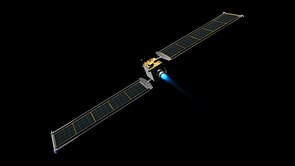|
As night hours lengthen in the northern hemisphere and the stars seem brighter this month, we’re entitled to stare up in awe. We see the brilliance of the heavens and the glory of shooting stars. Should we also stare up in fear? After all, 65 million years ago a massive meteor (six to nine miles wide) sped through the atmosphere, crashed into earth, and took out all the dinosaurs. Ten years ago, a sixty-pound asteroid plummeted to earth from space, crashed into Russia, and injured 1500 people in its path. What if a planet-killer ever headed our way? Could we somehow deflect it or are we defenseless? Fortunately for us earthlings, smart people at NASA and Johns Hopkins Applied Physics lab have been thinking about this. The Planetary Defense Coordination Office at NASA (surprise – there is one!) has been hard at work. On November 24, 2021, just a year ago, they launched a bold probe, sending a $325 million space craft the size of a refrigerator on a path to collide with an asteroid the size of a pyramid. The idea was not to explode the asteroid, but to nudge it off course. “Like throwing a tennis ball at a 747,” said NASA’s lead engineer Elena Adams. Use the momentum of the crash to give it a shove, and make it change orbit. Would it work? The asteroid selected, Didymos, was no threat to earth but it was conveniently located for a test, and it had a moonlet, named Dimorphos, that would serve as the target body to change the asteroid’s orbit. This “Double-Asteroid Redirection Test” or DART was a historic first: human beings were attempting to modify the orbit of a heavenly body. On September 26, just eight weeks ago, DART hit its target. A dramatic bullseye. It worked!  An illustration of DART's ion thrusters. An illustration of DART's ion thrusters. How could it not? Sending a 1260-pound spacecraft across seven million miles at a speed of 14,000 miles per hour and making sure, at the end of its ten-month journey, that it hit an asteroid moon so (relatively) small that scientists did not know its shape until just minutes before impact, when the cameras aboard would record its arrival. How could anything go wrong? Scientists at Johns Hopkins Applied Physics lab and NASA thrilled to watch DART hit its target and meet its demise, but the best news came in October (just weeks ago) as they confirmed DART had in fact changed the body’s trajectory. Earth’s telescopes had confirmed it. NASA’s goal was to slow the Dimorphos orbit by 10 minutes, but they exceeded their expectations and managed to slow it by 32 minutes, definitively altering the course of a celestial body. “This is a watershed moment for planetary defense and a watershed moment for humanity,” proclaimed Bill Nelson, NASA Administrator. It is technology that could protect all of us in the future. This Thanksgiving, I’m thankful that some people are looking up and thinking big. And that Earth is now a safer place. Bravo to those good stewards of our planet. Mary Beth Klee You can watch a presentation about the DART mission here. To read more from Telling Our Stories, visit our Blog Archives page. |
AuthorWrite something about yourself. No need to be fancy, just an overview. Archives
July 2024
Categories |
